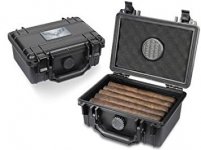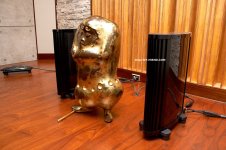Mechanical Defects : If there will be some minor manufacturing defect even after all care taken. We can do one thing. We give the test record to anyone who has ELP laser turntable. He/she will take measurements of all tracks and share it with everyone. This would be reference measurement to compare with individual measurements.a tool that was able to identify an actual manufacturing defect (and gave a valid reason for a refund) would be of use to every serious user.
Centering the offcenter : As some stylus may flex during aligning the washer and record another way would be to turn usb microscope vertical and watch the lead out groove itself. This may give more precise centering.
Chris,Hi Hiten,
That man's collection is lovely! Super nice!
-Chris
here is the link from where the picture was taken. There are lots of picture links.
Link
-o-o-o-
confession : I am not a staunch vinyl/analogue supporter. It is just that these mechanical things I find interesting.
Regards
My knowledge is weak so please bear with me. If a software from the measurements taken can give us information about speed variations, offcenter of spindle, record etc. it should also give us information about record offcenter. All we need is reference point on physical media (like label) so we can ignore it.
Regards
Regards
The eccentricity has never been a priority in record pressing. It could be caused by bad stamper alignment during punching. More likely the problem is the mould tolerances or alignment. Don't forget, this is old technology.
The center hole of each individual LP on this machine is done as it is pressed and I hadn't considered that the stamper might be off centre. It was an Ahah! moment.
Using a humidor for spare carts is pretty brilliant.
They make some for travel which could be suitable for those of us in hostile environments. $40 on amazon isn’t bad.

That rest of that tiawanese showroom is ridiculous. But honestly if i could walk out of there with one thing it might be that giant bronze statue.

They make some for travel which could be suitable for those of us in hostile environments. $40 on amazon isn’t bad.

That rest of that tiawanese showroom is ridiculous. But honestly if i could walk out of there with one thing it might be that giant bronze statue.

Side 1 & side 2 might have different centre eccentricity.
Are you going to release the best tracks as singles?
What about 12" single for setting up DJ decks.
The idea was just to align the 3150 kHz track on the test LP. I found the contrast poor with my camera imaging the grooves, this was easier for me.
OK here it is. I placed a cheap USB microscope over my cartridge as it was playing and watching on the screen I thought of retrograde planetary motion.
So here is my idea.
1) Ream out the hole on the LP just enough to find the true center
2) Get some 1" or so thin SS washers and ream their center holes to be a tight fit to your spindle
3) Put a tiny dot on the top of your cartridge, it does not matter how well centered it is. You could image any small feature on the cart if you want and in fact no alignment here is critical
4) Imaging the dot with a USB microscope rotate the platter by hand to find the min and max point of the wobble (the groove pitch is a small error to be aware of)
5)Mark with a piece of tape on your screen the min and max point of one revolution
6) Park the LP at one or the other and taking care to move the LP along the stylus/spindle radial axis split the difference. Two iterations should be more than enough.
7) Glue the washer in place to save the alignment
Picture is one iteration simply using the play in the Dr. Feickert LP (there was not enough play to fully fix it).
I do not know whether A and B sides match but my simple method is aligning the records by hand. Usually but not always there is some play between spindle and center hole, and it is usually enough play to center the record. I use a felt mat on the top of a rubber mat and watch the arm moving. Then giving the record small pushes with my finger (felt mat makes it slide quite easily) until I no longer can see the arm moving sideways. Takes 10-15 seconds. I have however not estimated the precision of the method, but I can upload some results later.
I do not know whether A and B sides match but my simple method is aligning the records by hand.
I was just trying to codify the process, simple Newton's method or successive approximation I guess. With the camera you can observe closely enough to virtually eliminate the retrograde motion.
Oh, OK. I thought it was drag caused by heavy modulation. It's just drag in any groove, then?
Modulation might increase drag, but really its just working out a repeatable way to measure the coastdown from X to Y RPM. Previous papers meausure time to stop, but that runs into other inaccuracies.
Apols for absence, I've been quite ill for a time, but on the mend now. Catching up backwards, yes drag or stylus groove friction is perhaps 'the thing' that's worth minimising in vinyl playback IMO. So measuring it in a quantifiable way seems pretty essential in my view.
I don't think there's a practical alternative to the stopping method.........?
LD
I don't think there's a practical alternative to the stopping method.........?
LD
As to azimuth and SRA, effects are typically dominated by various effects of minimal frictional drag, rather than geometric errors IMO. Stylus attitude dominates, except for spherical shapes.
So yes, one can minimise crosstalk and set generator azimuth, for example. But optimal stylus azimuth and SRA probably dominates sound quality.
LD
So yes, one can minimise crosstalk and set generator azimuth, for example. But optimal stylus azimuth and SRA probably dominates sound quality.
LD
But optimal stylus azimuth and SRA probably dominates sound quality.
I would assume folks would want to be able to do both and make up their own minds.
LD: welcome back. Glad to hear you are on the mend ( and I haven't forgotten I owe you some boards).
Ref the stopping method, there is an alternative but the calibration is messy as you need an optical sensing method to get bearing drag. Once you have that then the on record drag should be easily automatable between two velocities. I did find a program to print your own disk and added that to the round tuit pile.
Ref the stopping method, there is an alternative but the calibration is messy as you need an optical sensing method to get bearing drag. Once you have that then the on record drag should be easily automatable between two velocities. I did find a program to print your own disk and added that to the round tuit pile.
Modulation might increase drag, but really its just working out a repeatable way to measure the coastdown from X to Y RPM. Previous papers meausure time to stop, but that runs into other inaccuracies.
I would try the same thing I did for the TT speed plot as a first guess. Remove the belt and spin the table up by hand and drop the needle recording the 3150 Hz track and grab a big enough section to go from say 3000Hz to 500Hz and plot it at a few VTA settings. Unfortunately I would probably need to adjust VTA without adding weight to the platter. My gut feeling is that this will have poor resolution.
I could try +- on the tracking force just to see if I can see anything.
- Home
- Source & Line
- Analogue Source
- Test LP group buy